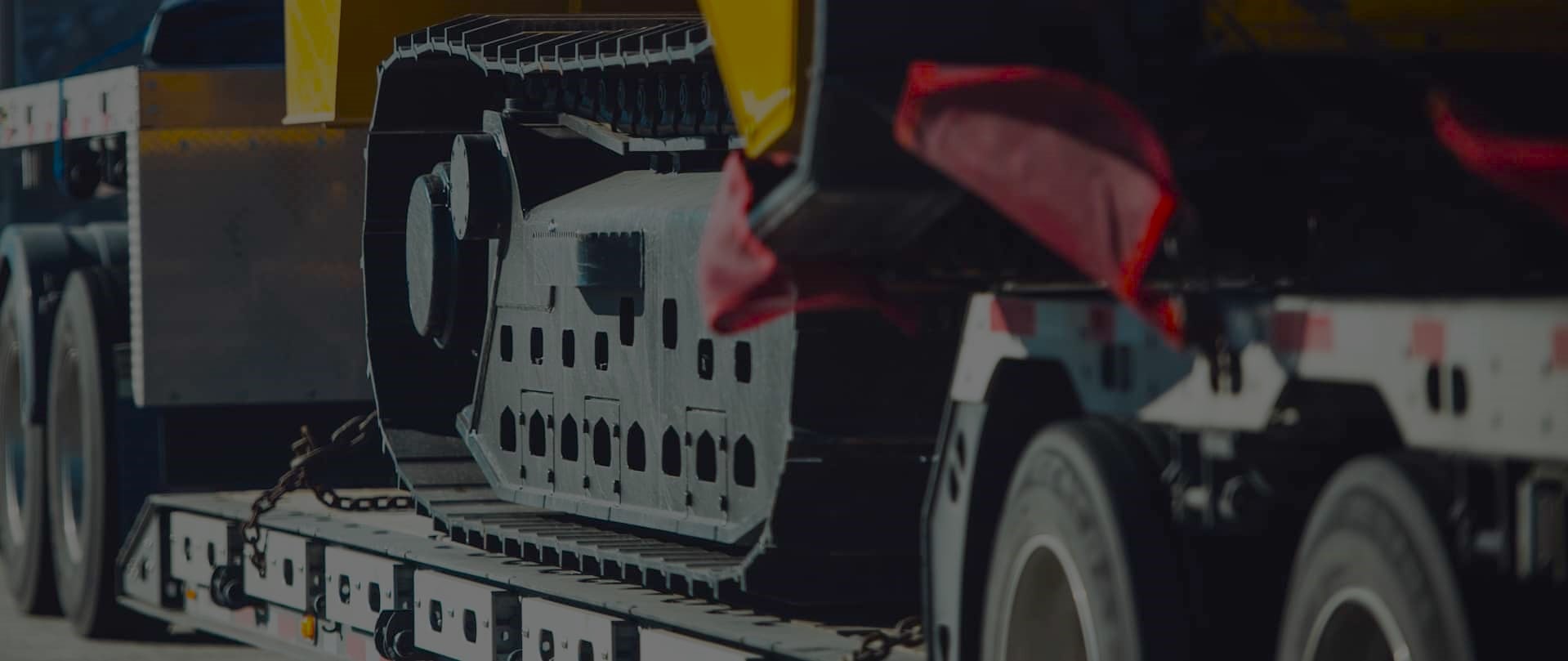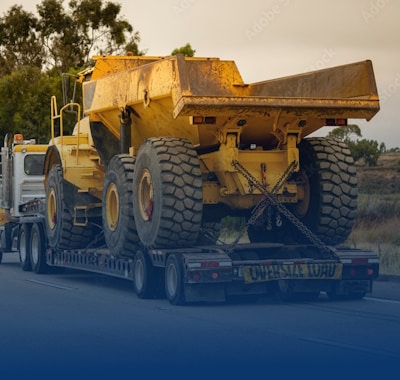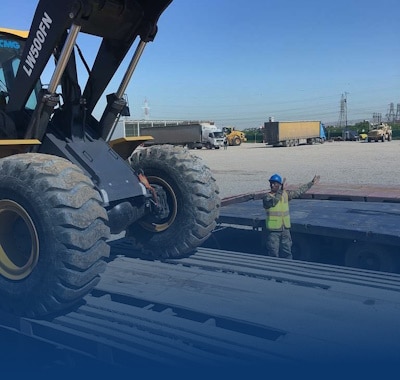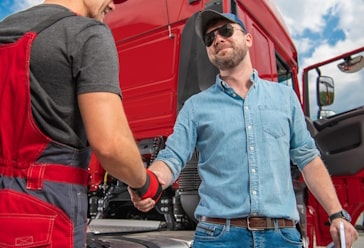Lowboy vs Double Drop Trailers in Michigan: Which is Best?
Freedom Heavy Haul can offer expedited Pickup and Delivery for any size shipment anywhere in the USA. Contact us today for No Hassle, No Pressure Pricing.
Michigan’s diverse terrain and stringent permit requirements make selecting the proper hauling equipment crucial. Whether transporting construction machinery or renewable energy components, stability and compliance are top priorities. We help businesses navigate these challenges with tailored solutions.
Deck height and load capacity directly impact safety on Michigan roads. Lower-profile options excel for oversized loads, while specialized designs handle taller equipment. Understanding these differences ensures efficient, damage-free transport.
Our expertise connects clients with carriers equipped for Michigan’s demands. From industrial applications to precision hauling, we prioritize reliability. For deeper insights, explore our guide on trailer variations and their ideal uses.
Understanding Lowboy and Double Drop Trailers
Transport efficiency hinges on matching loads to the right trailer type. Each design addresses specific hauling challenges, from height restrictions to weight distribution. We break down the key features to simplify your decision.
What Is a Lowboy Trailer?
Lowboy trailers feature an ultra-low deck, typically 6–8 feet high. Their fixed gooseneck provides stability for heavy machinery, with capacities exceeding 100,000 lbs. This type excels for construction equipment and industrial loads.
Unlike RGN (removable gooseneck) trailers, lowboys maintain a permanent connection between the deck and hitch. Their lower deck minimizes clearance issues, critical for Michigan’s overpasses. Explore our guide on lowboy trailer.
What Is a Double Drop Trailer?
Double drop trailers use a central well design, with raised sections at the front and rear. This creates space for taller loads (up to 12 feet) while keeping the center of gravity low. They’re ideal for wind turbine blades or modular buildings.
With capacities around 80,000 lbs, these trailers balance versatility and power. Their step deck configuration suits Michigan’s construction sector, where height clearance varies. We recommend them for freight requiring extra vertical room.
Lowboy vs Double Drop Trailers: Key Differences
Different trailer types excel in specific transport scenarios based on structural features. We break down critical distinctions to help businesses optimize their hauling operations.
Deck Height and Load Capacity
Ultra-low decks (6–8 feet) suit wind turbine blades in Michigan’s Upper Peninsula, minimizing clearance risks. In contrast, stepped designs (4–5 feet) accommodate excavators needing vertical space on I-75 routes.
| Feature | Type A | Type B |
|---|---|---|
| Deck Height | 6–8 feet | 4–5 feet |
| Max Capacity | 100,000+ lbs | 80,000 lbs |
| Ideal Load | Industrial generators | Modular buildings |
Axle Configuration and Stability
Four or more axles enhance stability for 200,000-lb generators, as seen in CarMax’s brake system study. Dual-drop axles prioritize maneuverability for urban deliveries in Detroit.
Loading and Unloading Ease
VeriTread data shows RGN designs improve efficiency in tight spaces. Ramps and hydraulic systems further streamline freight handling for time-sensitive projects.
Advantages of Lowboy Trailers for Heavy Hauling
When moving massive industrial equipment, stability and clearance are non-negotiable. Lowboy trailers excel where standard designs falter, offering unmatched safety for extreme weights. Their engineering solves critical challenges in heavy freight transport.
Ultra-Low Deck Height Benefits
A deck just 6–8 feet high minimizes overhead risks under bridges or power lines. This design cuts permit costs for height-restricted routes, as noted in VeriTread’s cost analysis.
Lower centers of gravity also reduce rollover risks on icy Michigan highways. CarMax’s extended decks prove this for mining gear in the Upper Peninsula.
Ideal Load Types
These trailers dominate moves requiring both capacity and precision. GM relies on them for stamping dies between Lansing and Flint. Other perfect fits:
| Load Type | Why It Works |
|---|---|
| Bridge components | Handles uneven weight distribution |
| Transformers | Fits height limits for urban routes |
| Combine harvesters | Stable base for farm equipment |
- Construction machinery: Excavators and cranes stay secure.
- Renewable energy: Wind turbine parts fit safely.
For more on specialized hauling, explore our partner resources.
Advantages of Double Drop Trailers in Michigan
For businesses needing to transport tall or bulky items, double drop trailers offer distinct advantages. Their unique design balances height clearance with stability, making them ideal for Michigan’s varied freight demands. We recommend them for industries prioritizing versatility and cost-efficiency.
Versatility for Taller Loads
These trailers handle loads up to 12 feet tall—perfect for prefab homes crossing the Mackinac Bridge. Their stepped deck design creates space for vertical freight without sacrificing road safety.
- Adjustable axles: Ideal for uneven forestry equipment in Manistee National Forest.
- Agricultural machinery: VeriTread reports 80% of Michigan’s farm gear moves on double drops.
Cost-Effectiveness
CarMax data shows a 20% lower upfront cost compared to lowboys—$45,000 vs. $65,000. Additional savings come from:
- Reduced permit fees for height-restricted routes.
- Fuel efficiency gains on long hauls to Grand Rapids.
Lighter frames and optimized weight distribution cut operational expenses. For businesses balancing budget and performance, these options deliver measurable value.
Disadvantages of Each Trailer Type
Every hauling solution has trade-offs that impact efficiency and cost. We help clients navigate these constraints to optimize their transport strategies. Below, we outline key limitations for both lowboy and double drop designs.
Lowboy Limitations
Specialized ramps are often required for loading, adding time and equipment costs. Michigan’s harsh winters accelerate wear on multi-axle systems, leading to:
- 30% more frequent inspections (CarMax data).
- Higher salt-corrosion risks for hydraulic components.
“Lowboys excel in capacity but demand rigorous upkeep—especially in cold climates.”
Double Drop Drawbacks
These trailers falter with extreme weight. DTE Energy’s 150,000-lb turbine bases, for example, exceed their capacity. Other challenges include:
| Issue | Impact |
|---|---|
| Low-clearance underpasses | Detroit Metro Airport routes require alternate paths |
| Resale value | 60% after 5 years vs. lowboys’ 70% |
Their step design also limits ground clearance on rough terrain. For businesses, balancing these factors ensures cost-effective operations.
Michigan-Specific Considerations
Navigating Michigan’s transport regulations demands careful planning for oversized shipments. We guide clients through permit logistics and route adaptations to ensure seamless freight movement across the state’s diverse landscapes.
Permit Requirements for Oversized Loads
MDOT mandates permits for loads exceeding 8.5 feet wide, with fees ranging $60–$150 on US-23 corridors. Key factors influencing costs:
- Weight thresholds: Escorts required for 80,000+ lbs on metro Detroit routes.
- Height restrictions: VeriTread reports 40% of specialized hauls need escorts versus 25% for standard configurations.
“Proper permitting prevents delays—especially for time-sensitive industrial moves.”
Terrain and Weather Adaptability
Michigan’s Upper Peninsula tests axles with icy roads and steep grades. CarMax’s cold-weather packages enhance hydraulic performance for reliable operation. Critical adaptations:
- Tire chains: Essential for snowy routes, but low-profile designs excel in stability.
- Mackinac Bridge’s 4% grade: Requires pre-trip checks on brake systems for heavy loads.
We prioritize route mapping tools to avoid low-clearance underpasses near Detroit Metro Airport. This balances efficiency with safety for every transportation need.
Choosing the Right Trailer for Your Needs
Selecting the ideal hauling solution requires careful evaluation of load specifications and operational demands. We guide clients through two critical factors: physical requirements and financial considerations. This ensures seamless transport while maximizing cost efficiency.
Assessing Load Dimensions and Weight
CarMax’s 5-step checklist simplifies load analysis:
- Measure height and width to avoid clearance issues.
- Verify weight limits for axle configurations.
- Map routes for low bridges or restrictive zones.
- Confirm timelines for permit processing.
- Choose trailers with 10% extra capacity for safety.
Ford’s Lansing plant reduced costs by 15% using double drops for engine blocks. Their streamlined process highlights how precise measurements improve outcomes.
Budget and Operational Costs
VeriTread’s analytics reveal stark rate differences:
| Trailer Type | Cost/Mile (Michigan) | Insurance Premiums |
|---|---|---|
| Lowboy | $3.50 | 20% higher |
| Double Drop | $2.80 | Standard |
We recommend using CarMax’s ROI calculator for 3–5-year projections. Key variables include:
- Maintenance costs (salt corrosion in winter).
- Resale value (60–70% after 5 years).
- Fuel efficiency gains per mile.
“Matching freight to trailer type cuts expenses by 12–18% annually.”
Industry Applications in Michigan
Michigan’s industries rely on specialized transportation solutions to move critical assets safely. From bridge components to wind turbines, choosing the right equipment ensures timely project completion. We help businesses match their needs with the optimal hauling setup.
Construction and Machinery Transport
Kokosing Construction trusts double drops for I-94 bridge girder deliveries, leveraging their stepped deck for stability. These trailers used for heavy machinery offer:
- Adjustable axles for uneven loads like forestry gear
- 20% faster loading times compared to standard designs (CarMax data)
John Deere relies on them for 80% of its wind turbine components. Their versatility handles everything from modular offices to mining equipment.
Renewable Energy Equipment Hauling
GE’s 250-ft turbine blades navigate Thumb region backroads safely with lowboys. Their ultra-low profile minimizes overhead risks, while reinforced goosenecks handle extreme weights. Key advantages:
| Feature | Benefit |
|---|---|
| Hydraulic suspension | Smoother operation on rural routes |
| Extended decks | Fits blades up to 300 feet |
VeriTread reports 320 monthly renewable energy loads in Michigan. Future trends include electric lowboys for GM’s Factory Zero initiative, reducing emissions for sustainable hauling.
“Specialized freight demands precision—our carriers deliver 98% on-time rates for energy sector clients.”
For tailored solutions, explore our lowboy trailer services designed for industrial challenges.
Making the Best Decision for Your Transport Needs
Safety and efficiency start with matching your freight to the right equipment. We prioritize solutions that meet your hauling needs while ensuring compliance and reliability.
VeriTread’s platform streamlines Michigan’s 1,200+ daily heavy hauls with precision. CarMax backs lowboys with 5-year structural warranties—proof of enduring performance.
- Consult MDOT for permit specifics before finalizing your trailer choice.
- Access real-time bids via VeriTread’s portal for Detroit and Grand Rapids routes.
Your load’s capacity and route challenges demand expertise. Trust our team to guide you to the right trailer—because every haul deserves a safe, efficient solution.







